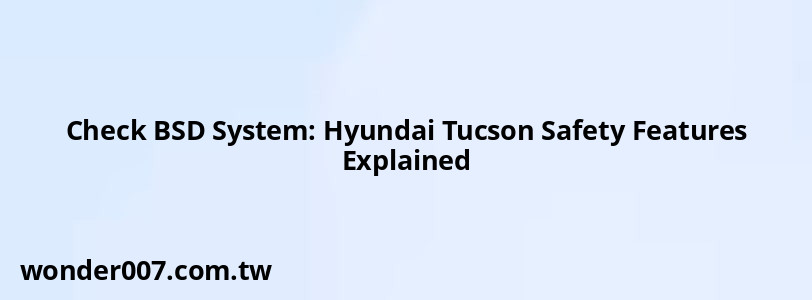Check BSD System: Hyundai Tucson Safety Features Explained

The Blind Spot Detection (BSD) system in the Hyundai Tucson is an advanced safety feature designed to enhance driver awareness and prevent accidents. This technology is particularly beneficial for drivers who frequently change lanes or navigate tight spaces, as it helps to monitor areas that are typically difficult to see.
Understanding Blind Spot Detection (BSD)
The Blind Spot Detection system uses radar sensors located in the rear bumper of the vehicle. These sensors continuously monitor the areas adjacent to the vehicle, specifically focusing on blind spots. When another vehicle enters this monitored area, the system provides visual and audible alerts to the driver, helping to prevent potential collisions during lane changes.
How BSD Works
- Detection Range: The BSD system effectively covers the rear three-quarters of the vehicle, typically referred to as the 7 o'clock and 5 o'clock positions.
- Warning Signals: If a vehicle is detected in the blind spot, an amber indicator light illuminates on the corresponding side mirror. If the driver signals a lane change while a vehicle is in the blind spot, the warning light will blink, accompanied by an audible alert or steering wheel vibration.
- Rear Cross-Traffic Alert: This feature enhances safety when reversing from parking spots. It alerts drivers to approaching vehicles from either side.
Common Issues and Resolutions
Drivers may encounter issues with their BSD system, often indicated by a "Check BSD System" warning on the dashboard. Here are some common problems and solutions:
- Sensor Obstruction: Mud or debris can obstruct radar sensors, leading to malfunctions. Regular cleaning of the rear bumper area can help maintain sensor functionality.
- Calibration Issues: If the BSD system fails to operate correctly after sensor replacement or repair, recalibration may be necessary. This process often requires specialized diagnostic tools available at dealerships.
- Electrical Problems: Faulty wiring or battery issues can trigger warning messages. A thorough inspection by a certified technician is recommended if these issues persist.
Benefits of Using BSD in Hyundai Tucson
The implementation of BSD technology significantly enhances driving safety by:
- Reducing Accidents: By providing timely warnings about vehicles in blind spots, BSD minimizes the risk of collisions during lane changes.
- Improving Driver Confidence: Knowing that there is an additional layer of monitoring allows drivers to make safer decisions while driving.
- Supporting New Drivers: For less experienced drivers, BSD serves as a valuable aid in navigating complex traffic situations.
FAQs About Blind Spot Detection in Hyundai Tucson
FAQs About Check BSD System
- What should I do if I see a "Check BSD System" warning?
Inspect for any obstructions around the sensors and consult your dealer for diagnostics if the issue persists. - Can I turn off the BSD system?
Yes, you can disable it through your vehicle's settings menu under driver assistance features. - How do I reset my Hyundai's BSD system?
Resetting may require using a detection tool for calibration; consult your dealer for assistance.
In conclusion, understanding and maintaining your Hyundai Tucson's Blind Spot Detection system is crucial for ensuring optimal performance and safety on the road. Regular checks and awareness of how this technology works can significantly enhance your driving experience.
Related Posts
-
2011 Hyundai Santa Fe Headlight Bulb Replacement
30-01-2025 • 97 views -
2017 Hyundai Santa Fe Brake Pads: Essential Guide
27-01-2025 • 166 views -
Ski-Doo Check Engine Light: 4 Beeps Explained
27-01-2025 • 171 views -
2003 Hyundai Santa Fe Tire Size Guide
28-01-2025 • 110 views -
Bypassing a Clutch Safety Switch: A Guide
29-01-2025 • 129 views
Latest Posts
-
Rear Brake Caliper Piston Won't Compress
01-02-2025 • 273 views -
How To Turn Off Paddle Shifters Mercedes
01-02-2025 • 289 views -
2015 Chevy Traverse AC Recharge Port Location
01-02-2025 • 327 views -
Power Steering Fluid Leak On Passenger Side
01-02-2025 • 369 views -
Are O2 Sensors Covered Under Warranty
01-02-2025 • 299 views
Popular Posts
-
EPC Warning Light: What It Means for Your Vehicle
27-01-2025 • 549 views -
2015 VW Passat Oil Consumption Issues Explained
26-01-2025 • 532 views -
V12 Engine Costs: What You Need to Know
26-01-2025 • 551 views -
Power Steering and ABS Light On: Causes and Solutions
27-01-2025 • 567 views -
EPC Light: Understanding Causes and Solutions
26-01-2025 • 968 views
